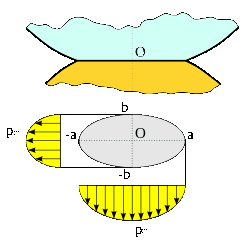When two objects come into contact, depending on the shape of the surfaces, there may be point or line contact. The contact force causes deformation and thus stresses in the material. If these material stresses are high, the material may fail.
The material stresses in point and line contacts are not uniformly distributed. Most stresses in the common contact area decrease slowly as the distance from the contact increases. However, a shear stress reaches its maximum at some distance from the contact surface.
The stresses in point and line contacts are caused by several factors. These are the geometry of the contact surfaces, the mechanical properties of the materials, and the loads applied to the contact. To understand and control these stresses, it is important to understand the physical and mechanical properties of the materials involved and the contact conditions. This can be accomplished through experimental studies and theoretical modeling.
What did the German Heinrich Hertz contribute?
Heinrich Hertz was a German physicist who is best known for his research on electromagnetic waves. His work indirectly contributed to the understanding of material stresses in point and line contacts.
Hertz discovered that electromagnetic waves can propagate in space, and that their frequency and wavelength depend on the properties of the source of the waves. These discoveries laid the foundation for the development of wireless communications and electromagnetic technologies.
Hertz was not directly involved in research on material stresses in point and line contacts. But his discoveries about electromagnetic waves contributed to the understanding of the physical principles underlying these stresses. This led to further developments and applications in materials science and mechanical engineering.
What mechanical engineering developments and applications has Hertz contribute to?
Hertz indirectly contributed to several developments and applications in mechanical engineering. In 1882, Heinrich Hertz published his classic paper on the contact of elastic bodies: Über die berürung fester elastischer körper, in the Journal für die reine und angewandte mathematik 92. The article gave a significant impulse to technical developments in railroads, gears, and the rolling bearing industry, among others. Some examples are given below:
Material characterization: Hertz’s work led to a better understanding of the mechanical properties of materials, including their elasticity and resistance to deformation. This has led to a better understanding of how materials behave under different loads and conditions. And has contributed to the development of advanced materials for use in mechanical engineering applications.
Contact Mechanics: Hertz developed a model for the elastic deformation of contact surfaces between materials under pressure. This model is still used today to predict contact stresses and surface wear in machines. The HertzWin program is ideal for calculating these stresses in a simple way.
Tribology: Tribology is the science of friction, wear and lubrication in machines. Understanding material stresses and contact mechanics is essential to understanding tribological phenomena. This has led to the development of advanced lubricants, coatings and surface treatments that contribute to machine durability and reliability.
Mechanical Design: The understanding of material stresses and contact mechanics has contributed to the development of better mechanical designs, including the design of bearings, gears, couplings, and other machine components. This has led to better performance, higher efficiency, and longer machine life.
In short, Hertz’s work on electromagnetic waves has indirectly contributed to the development of many engineering applications through a better understanding of material stresses and contact mechanics.
